 UPDATED REVIEW – July 1, 2024 | Casio AP-470 Celviano Digital Piano | LOWER PRICE HERE | The Casio AP-470 at $1699 internet price is a very popular model under $1700 and is offered in matte black, matte walnut brown, and matte white with matching height adjustable benches. This model has an upgraded stereo piano sound engine, improved piano key action, responsive pedaling, and a stereo 4 speaker sound system along with adding some new, impressive interactive features such as a proprietary controller app for iPad or Android called “Casio Music Space.” This new app allows you to control the piano features and functions from your tablet color touch screen in a more intuitive way which the previous models could not do.
UPDATED REVIEW – July 1, 2024 | Casio AP-470 Celviano Digital Piano | LOWER PRICE HERE | The Casio AP-470 at $1699 internet price is a very popular model under $1700 and is offered in matte black, matte walnut brown, and matte white with matching height adjustable benches. This model has an upgraded stereo piano sound engine, improved piano key action, responsive pedaling, and a stereo 4 speaker sound system along with adding some new, impressive interactive features such as a proprietary controller app for iPad or Android called “Casio Music Space.” This new app allows you to control the piano features and functions from your tablet color touch screen in a more intuitive way which the previous models could not do.
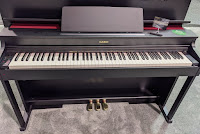 Sometimes upgrades are not very noticeable in newer models and sometimes they are. In this case, the upgrades make the piano playing experience a lot more enjoyable than in previous Casio models and that’s what really counts. After personally playing this the AP-470 many times, here are some of the main reasons (below) why this digital home piano is, in my opinion, one of the best digital pianos under $1700 for 2024 that you can buy, especially if you are looking for a very satisfying piano playing experience from beginner level all the way up to more advanced playing along with having a beautifully designed furniture style cabinet. (click on pics for larger views)
Sometimes upgrades are not very noticeable in newer models and sometimes they are. In this case, the upgrades make the piano playing experience a lot more enjoyable than in previous Casio models and that’s what really counts. After personally playing this the AP-470 many times, here are some of the main reasons (below) why this digital home piano is, in my opinion, one of the best digital pianos under $1700 for 2024 that you can buy, especially if you are looking for a very satisfying piano playing experience from beginner level all the way up to more advanced playing along with having a beautifully designed furniture style cabinet. (click on pics for larger views)KEY ACTION
 The piano key actions in Casio digital pianos are very consistent in being able to replicate a nicely balanced and piano weighted key movement with very good response under the fingers. I have always liked the way the keys move in terms of weight and speed and I know that many people at all skill levels agree with me. There are 3 key sensors under each key which allow for better key repetition recognition than some other digital pianos along with a more natural graded weight as opposed to brands that have keys that are either too light or much too firm. One of the new improvements on the AP-470 is the new proprietary synthetic ebony and ivory keytops that are now smooth and more lifelike as compared to previous models that were highly textured.
The piano key actions in Casio digital pianos are very consistent in being able to replicate a nicely balanced and piano weighted key movement with very good response under the fingers. I have always liked the way the keys move in terms of weight and speed and I know that many people at all skill levels agree with me. There are 3 key sensors under each key which allow for better key repetition recognition than some other digital pianos along with a more natural graded weight as opposed to brands that have keys that are either too light or much too firm. One of the new improvements on the AP-470 is the new proprietary synthetic ebony and ivory keytops that are now smooth and more lifelike as compared to previous models that were highly textured. This is the same thing that happens in digital pianos only digital pianos can be played very quietly because you can turn down the volume, so then you more easily hear the keys move, but that’s fairly normal for digital pianos. The AP-470 also has full 256-note (maximum) polyphony piano processing power so notes don’t drop out when playing many notes or instruments at one time. With a fast action, 3-sensor responsive hammer weighted & graded key action, overall I believe the Casio key action in the AP-470 is more natural than ever before and enjoyable to play, especially as compared to other top brands in this price range including Yamaha and Roland.
This is the same thing that happens in digital pianos only digital pianos can be played very quietly because you can turn down the volume, so then you more easily hear the keys move, but that’s fairly normal for digital pianos. The AP-470 also has full 256-note (maximum) polyphony piano processing power so notes don’t drop out when playing many notes or instruments at one time. With a fast action, 3-sensor responsive hammer weighted & graded key action, overall I believe the Casio key action in the AP-470 is more natural than ever before and enjoyable to play, especially as compared to other top brands in this price range including Yamaha and Roland.
PIANO SOUND
 The Casio AP-470 has a new piano sound chip which is improved over the previous model in a number of ways. They added a new custom made New York Steinway concert grand piano sound sample which is quite unique to find in a digital piano and definitely different than the more traditional Casio acoustic grand sample they have been using in their digital pianos. Not only is the New York Steinway piano reproduction a very good one with lots of expression, but the tonal consistency and dynamic tonal nuances of that sound is quite impressive and I believe those people who play at higher skill levels will really appreciate that.
The Casio AP-470 has a new piano sound chip which is improved over the previous model in a number of ways. They added a new custom made New York Steinway concert grand piano sound sample which is quite unique to find in a digital piano and definitely different than the more traditional Casio acoustic grand sample they have been using in their digital pianos. Not only is the New York Steinway piano reproduction a very good one with lots of expression, but the tonal consistency and dynamic tonal nuances of that sound is quite impressive and I believe those people who play at higher skill levels will really appreciate that.
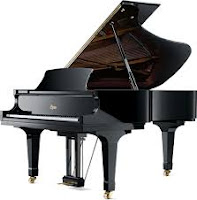
There are many more elements of a natural acoustic sound in the AP470 sound chip than can be found in many other brands and models of new digital pianos in this price range, especially as compared to the Yamaha Arius pianos in this same price range. But Yamaha has not upgraded their piano sound chip in a number of years so they need to come out with something new to compete with the newer Casio Celviano pianos. The acoustic piano sounds have even more natural expression with a wider dynamic tonal range for an evenly balanced transitional tone from mellow to bright when playing any notes from low octaves to higher octaves.
INSTRUMENT SOUNDS
 In the AP-470 there are other piano and instrument sounds giving it a total of 22 sounds including 9 different acoustic piano sound variations, 4 different electric pianos, harpsichord, 2 string symphony variations, 4 organ sounds, and a string bass to be used on the lower part of the keyboard. But it’s the piano sounds that most people focus on and want to play. Casio has 2 distinct sound samples which include the New York Steinway grand and their traditional European grand (which is quite nice and very expressive) along with variations of each of those sound samples giving you nine piano variations total as I mentioned. The other non-piano instrument sounds are actually very realistic and in my opinion all the sounds that the AP-470 offers are more authentic than what Yamaha or Roland has to offer with those specific sounds in this price range.
In the AP-470 there are other piano and instrument sounds giving it a total of 22 sounds including 9 different acoustic piano sound variations, 4 different electric pianos, harpsichord, 2 string symphony variations, 4 organ sounds, and a string bass to be used on the lower part of the keyboard. But it’s the piano sounds that most people focus on and want to play. Casio has 2 distinct sound samples which include the New York Steinway grand and their traditional European grand (which is quite nice and very expressive) along with variations of each of those sound samples giving you nine piano variations total as I mentioned. The other non-piano instrument sounds are actually very realistic and in my opinion all the sounds that the AP-470 offers are more authentic than what Yamaha or Roland has to offer with those specific sounds in this price range.
PIANO PEDALS AND SUSTAIN
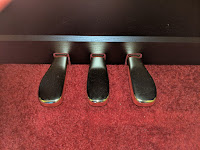 Another part of piano playing that is sometimes overlooked but is essential to any piano are the pedals. Although there are 3 pedals on a regular piano, it’s the right damper-sustain pedal that is used 95% of the time by most people playing piano and the other two pedals are seldom used although the left soft pedal is used in playing piano some of the time depending what your piano playing skill level is and what song you are playing. When you press down the pedals then those pedals need to respond correctly in terms of how much weight from your foot it takes to press the pedal, how the pedals move, and on the right pedal, how is triggers the damper sustained tone. Also, when it comes to the right pedal and the sustained piano tone, when you hold down the pedal and play a piano sound in the middle of the keyboard, that piano sound should fade out on its own after a little while when you are holding down the pedal.
Another part of piano playing that is sometimes overlooked but is essential to any piano are the pedals. Although there are 3 pedals on a regular piano, it’s the right damper-sustain pedal that is used 95% of the time by most people playing piano and the other two pedals are seldom used although the left soft pedal is used in playing piano some of the time depending what your piano playing skill level is and what song you are playing. When you press down the pedals then those pedals need to respond correctly in terms of how much weight from your foot it takes to press the pedal, how the pedals move, and on the right pedal, how is triggers the damper sustained tone. Also, when it comes to the right pedal and the sustained piano tone, when you hold down the pedal and play a piano sound in the middle of the keyboard, that piano sound should fade out on its own after a little while when you are holding down the pedal.
 it may take 15-20 seconds or more before the piano sound fades out when you hold down the sustain pedal.However, on many digital pianos, especially the “cheap” off-brands, that piano sound may fade out after only 4-6 seconds which makes the music sound choppy and not at all like it is supposed to sound. Unlike other brands and models or digital pianos from the past which had short decay times, the AP-470 has noticeably longer sustain pedal decay times for its acoustic piano sounds. This is due to a big increase in the power that comes from the new digital piano sound chip in the AP-470 model.
it may take 15-20 seconds or more before the piano sound fades out when you hold down the sustain pedal.However, on many digital pianos, especially the “cheap” off-brands, that piano sound may fade out after only 4-6 seconds which makes the music sound choppy and not at all like it is supposed to sound. Unlike other brands and models or digital pianos from the past which had short decay times, the AP-470 has noticeably longer sustain pedal decay times for its acoustic piano sounds. This is due to a big increase in the power that comes from the new digital piano sound chip in the AP-470 model.COOL “BELLS & WHISTLES”
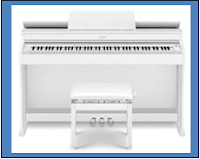 When it comes to extra features, the AP-470 has no shortage of other things it can do. It has a key transpose function, touch response control for hard, normal, of soft, octave shift for instrument sounds, brilliance control to apply brighter or mellower tone to the piano sounds, a digital metronome with tempo & time signature control, layer & splitting any two sounds, chorus effect to add to electric piano sounds to give them more body and presence, relative volume control between layers or splits, and a duet mode allowing for two people (parent-student, teacher-student, siblings, etc) to play the same song with the same notes simultaneously by electronically splitting the 88 notes into two separate 44-note keyboards independent of each other, the Casio AP-470 offers some cool features but these features are also typically found in other brands and models of name brand digital pianos in this price range.
When it comes to extra features, the AP-470 has no shortage of other things it can do. It has a key transpose function, touch response control for hard, normal, of soft, octave shift for instrument sounds, brilliance control to apply brighter or mellower tone to the piano sounds, a digital metronome with tempo & time signature control, layer & splitting any two sounds, chorus effect to add to electric piano sounds to give them more body and presence, relative volume control between layers or splits, and a duet mode allowing for two people (parent-student, teacher-student, siblings, etc) to play the same song with the same notes simultaneously by electronically splitting the 88 notes into two separate 44-note keyboards independent of each other, the Casio AP-470 offers some cool features but these features are also typically found in other brands and models of name brand digital pianos in this price range.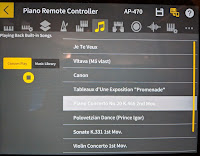 The unique proprietary features offered on this model include having a “Concert Play” music library incorporating 10 fully orchestrated popular classical songs in audio wav files built into the piano for play-along where the songs can be controlled for speed to slow it down without affecting the pitch of the song, part mute, separate volume control to balance the song playback with the live play volume of the piano, and 3-step learning in a way that makes even a pure beginner sound great. I have personally used this concert-play system and Casio did a great job of offering beautifully orchestrated music in a play-along learning format that you just do not get on other digital pianos, especially in this price range. Another exclusive feature is the Hall Simulator which allows the piano to resonate just like it would be heard in specific buildings or structures like a large Dutch Church, A old French Cathedral, or Concert Hall.
The unique proprietary features offered on this model include having a “Concert Play” music library incorporating 10 fully orchestrated popular classical songs in audio wav files built into the piano for play-along where the songs can be controlled for speed to slow it down without affecting the pitch of the song, part mute, separate volume control to balance the song playback with the live play volume of the piano, and 3-step learning in a way that makes even a pure beginner sound great. I have personally used this concert-play system and Casio did a great job of offering beautifully orchestrated music in a play-along learning format that you just do not get on other digital pianos, especially in this price range. Another exclusive feature is the Hall Simulator which allows the piano to resonate just like it would be heard in specific buildings or structures like a large Dutch Church, A old French Cathedral, or Concert Hall.RECORDING FEATURES
 The AP-470 also has two digital recorders; one being a 2-track MIDI recorder located on the piano control panel allowing for independent recording of left and right hand for practicing songs and then playing them back one hand at a time. This is a very useful technique for properly learning a piece of music and being able to actually listen back to your left and right hand part separately and see how it sounded and then also play both parts back simultaneously to hear how both parts sound together as they should be. This is a great feature and I use this type of recording method when teaching students how to recognize their mistakes while they were playing the lesson song. The 2nd recording feature is a 1-track audio wav file recording which allows you to record the song in one “take” or track with that song being recorded in CD quality as a audio wav file.
The AP-470 also has two digital recorders; one being a 2-track MIDI recorder located on the piano control panel allowing for independent recording of left and right hand for practicing songs and then playing them back one hand at a time. This is a very useful technique for properly learning a piece of music and being able to actually listen back to your left and right hand part separately and see how it sounded and then also play both parts back simultaneously to hear how both parts sound together as they should be. This is a great feature and I use this type of recording method when teaching students how to recognize their mistakes while they were playing the lesson song. The 2nd recording feature is a 1-track audio wav file recording which allows you to record the song in one “take” or track with that song being recorded in CD quality as a audio wav file.CASIO MUSIC SPACE APP FOR IPAD & ANDROID
 For 2024 Casio has done something quite special for their new digital pianos and designed their first “controller” app for digital tablet (iPad, Android) calledCasio Music Space. This impressive app is available so that you can control the functions and features of the AP-470 through a USB connection from an intuitive user interface on your iPad color touch screen instead of needing to always rely on less intuitive controls on the piano itself. For many years Casio and other digital piano companies have stuffed all kinds of sounds and features into their digital pianos which required a lot of buttons, sliders and other hardware on the piano to operate correctly. However, because of consumer demand, digital piano companies wanted to reduce the physical and electronic “clutter” on their digital pianos so that the cabinets would look more streamlined and minimalistic to give those cabinets a more natural piano look to them.
For 2024 Casio has done something quite special for their new digital pianos and designed their first “controller” app for digital tablet (iPad, Android) calledCasio Music Space. This impressive app is available so that you can control the functions and features of the AP-470 through a USB connection from an intuitive user interface on your iPad color touch screen instead of needing to always rely on less intuitive controls on the piano itself. For many years Casio and other digital piano companies have stuffed all kinds of sounds and features into their digital pianos which required a lot of buttons, sliders and other hardware on the piano to operate correctly. However, because of consumer demand, digital piano companies wanted to reduce the physical and electronic “clutter” on their digital pianos so that the cabinets would look more streamlined and minimalistic to give those cabinets a more natural piano look to them.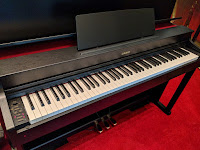 To accomplish this goal the manufacturers put many of their functions and features in a menu on the piano accessed by a single function button and pressing a specific key on the piano to trigger that function.Some other functions are accessed by pressing a button multiple times to get the function you were looking for. To really know what feature you were selecting you needed to sometimes go into the owners manual to find a chart for these features and look at that somewhat cryptic chart to see where the functions were located on the keys. There are certain digital piano companies that still do this on many of their models and some shoppers don’t care but many shoppers do care about getting a digital piano which is easier and more user friendly to operate and maintains a minimalist appearance.
To accomplish this goal the manufacturers put many of their functions and features in a menu on the piano accessed by a single function button and pressing a specific key on the piano to trigger that function.Some other functions are accessed by pressing a button multiple times to get the function you were looking for. To really know what feature you were selecting you needed to sometimes go into the owners manual to find a chart for these features and look at that somewhat cryptic chart to see where the functions were located on the keys. There are certain digital piano companies that still do this on many of their models and some shoppers don’t care but many shoppers do care about getting a digital piano which is easier and more user friendly to operate and maintains a minimalist appearance.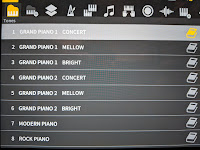 To balance out making the digital piano look nice along with having fewer buttons but still offering many cool, useful features that need to be easily accessed, a few different digital piano manufacturers have recently come out with proprietary “controller apps” designed to let you access and interact with the controls of the piano through your iPad tablet.The Casio company recently came out with their first piano controller app and it’s very cool. But if you don’t have a digital tablet like an iPad then you can still certainly access many of the cool “extra” functions on the AP470 from the left side control panel on the piano with some nice easy to use buttons that are intuitive ?.
To balance out making the digital piano look nice along with having fewer buttons but still offering many cool, useful features that need to be easily accessed, a few different digital piano manufacturers have recently come out with proprietary “controller apps” designed to let you access and interact with the controls of the piano through your iPad tablet.The Casio company recently came out with their first piano controller app and it’s very cool. But if you don’t have a digital tablet like an iPad then you can still certainly access many of the cool “extra” functions on the AP470 from the left side control panel on the piano with some nice easy to use buttons that are intuitive ?.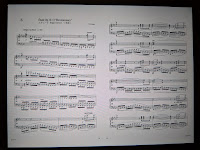 I have tried the Casio Music Space app out in person on the AP-470 and in my opinion Casio has really done an impressive job designing this new multi-use controller app for tablet because not only does it offer very nicely laid out and engaging controls for the functions on the piano, but it also offers additional interactive technology including Music Score PDF files displaying music on an iPad for the internal song library in the piano. It also has a Piano Roll feature with follow-along songs for learning and music fun. For the AP470 you can select all the instrument sounds with the Casio Music Space app, control the volumes of different set-ups, use the special 2-track recorder and talked about earlier and operate it much more easily, easily change transpose key, change touch sensitivity control, octave shift, select and play the music library and Concert-Play songs, and so much more.
I have tried the Casio Music Space app out in person on the AP-470 and in my opinion Casio has really done an impressive job designing this new multi-use controller app for tablet because not only does it offer very nicely laid out and engaging controls for the functions on the piano, but it also offers additional interactive technology including Music Score PDF files displaying music on an iPad for the internal song library in the piano. It also has a Piano Roll feature with follow-along songs for learning and music fun. For the AP470 you can select all the instrument sounds with the Casio Music Space app, control the volumes of different set-ups, use the special 2-track recorder and talked about earlier and operate it much more easily, easily change transpose key, change touch sensitivity control, octave shift, select and play the music library and Concert-Play songs, and so much more.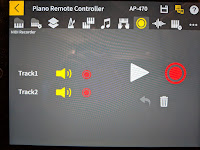 You can even bring up music notation to read on your tablet while playing the songs from it and there’s so much more you can do as well…all from the large color touchscreen on your iPad (or Android). If you don’t already have a digital tablet (ie: iPad, Android), buying this new Casio AP-470 is a very good excuse to go get one. You don’t have to buy the latest greatest iPad (tablet) to use with the piano…even some slightly older models will work just fine as long as the operating system is brought up-to-date. But no matter how you slice and dice it, Casio have finally arrived into the future with having created a multi-function useful and intuitive app to much more easily control the functions on the AP-470 along with being able to do many other fun things on the piano while interacting with and enjoying piano playing more than ever.
You can even bring up music notation to read on your tablet while playing the songs from it and there’s so much more you can do as well…all from the large color touchscreen on your iPad (or Android). If you don’t already have a digital tablet (ie: iPad, Android), buying this new Casio AP-470 is a very good excuse to go get one. You don’t have to buy the latest greatest iPad (tablet) to use with the piano…even some slightly older models will work just fine as long as the operating system is brought up-to-date. But no matter how you slice and dice it, Casio have finally arrived into the future with having created a multi-function useful and intuitive app to much more easily control the functions on the AP-470 along with being able to do many other fun things on the piano while interacting with and enjoying piano playing more than ever.
INTERNAL SPEAKER SYSTEM
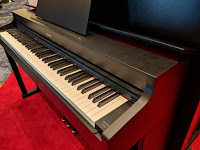 With regard to the internal speaker system and internal sound projection, the AP-470 really shines in this area based on my personal experience with it. First of all, it has stereo amplification of 40 watts going into 4 speakers which offers a good amount of power and the 4 speakers is more than most digital pianos in this price range which offer only 2 internal speakers . Beyond that, the AP-470 offers a unique piano sound projection system by designing this piano with a top lid that can be propped up and kept open to more easily project the sound towards the player rather than have the sound contained and boxed into the piano where the speakers are only underneath the piano pointing down which is the case on all the other popular digital pianos under $1700 out there.
With regard to the internal speaker system and internal sound projection, the AP-470 really shines in this area based on my personal experience with it. First of all, it has stereo amplification of 40 watts going into 4 speakers which offers a good amount of power and the 4 speakers is more than most digital pianos in this price range which offer only 2 internal speakers . Beyond that, the AP-470 offers a unique piano sound projection system by designing this piano with a top lid that can be propped up and kept open to more easily project the sound towards the player rather than have the sound contained and boxed into the piano where the speakers are only underneath the piano pointing down which is the case on all the other popular digital pianos under $1700 out there.CONNECTIVITY
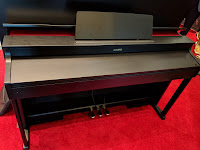 As far as digital and audio connectivity is concerned, the AP-470 has two 1/4″ stereo headphone jacks on the left side front of the piano for playing in privacy with up to two people using headphones simultaneously. Also, one of those stereo headphone jacks can also be used to connect the piano to an external sound system if you are playing in a big venue, church, school, etc. When normally connecting any device through a headphone jack, the internal speakers are cutoff and muted. However, with the new AP-470 there is a mode that can be set to turn the internal speakers back on so that the player can monitor their playing through the internal speakers while the external speakers are also still on. This is a nice feature for digital pianos that have no separate audio output jacks which is the case with the AP-470.
As far as digital and audio connectivity is concerned, the AP-470 has two 1/4″ stereo headphone jacks on the left side front of the piano for playing in privacy with up to two people using headphones simultaneously. Also, one of those stereo headphone jacks can also be used to connect the piano to an external sound system if you are playing in a big venue, church, school, etc. When normally connecting any device through a headphone jack, the internal speakers are cutoff and muted. However, with the new AP-470 there is a mode that can be set to turn the internal speakers back on so that the player can monitor their playing through the internal speakers while the external speakers are also still on. This is a nice feature for digital pianos that have no separate audio output jacks which is the case with the AP-470.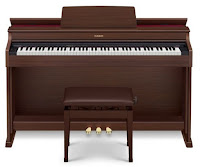 This piano also has a USB/MIDI out output jack to connect to external devices such as computers, tablets, etc to use interactive music programs and apps which are now widely available.There is also a built-in USB flashdrive input for saving both 1-track audio wav file and 2-track MIDI recordings that you can do on the piano and then storing them on the flashdrive for later playback from a custom song library you the user can create. Along with this feature you can also download regular MIDI piano song files from the internet, load them into a flashdrive and then play them back on the piano so you can play along with those songs. This is a very useful way of learning new songs as well as having fun playing along with other music.
This piano also has a USB/MIDI out output jack to connect to external devices such as computers, tablets, etc to use interactive music programs and apps which are now widely available.There is also a built-in USB flashdrive input for saving both 1-track audio wav file and 2-track MIDI recordings that you can do on the piano and then storing them on the flashdrive for later playback from a custom song library you the user can create. Along with this feature you can also download regular MIDI piano song files from the internet, load them into a flashdrive and then play them back on the piano so you can play along with those songs. This is a very useful way of learning new songs as well as having fun playing along with other music.
CABINET
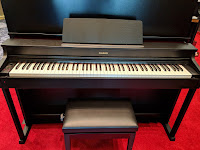 The cabinet design, structure, and appearance of this AP-470 piano definitely has the most traditional “furniture” looking appearance of any digital piano under $1700 that I know of given that it has an attractive, sturdy cabinet offered in 3 distinct matte color finishes with front support legs for extra cabinet stability and a more formal look to it. Along with the lid that raises up, the AP-470 has a full size music support rack, a built-in metal sliding key cover, and a high quality height adjustable matching padded bench (no one else in this price range offers a height adjustable padded bench which is an upgraded item), the AP-470 is a “total package” with functions and features that the vast majority of piano shoppers seem to be looking for in the lower price range under $1700.
The cabinet design, structure, and appearance of this AP-470 piano definitely has the most traditional “furniture” looking appearance of any digital piano under $1700 that I know of given that it has an attractive, sturdy cabinet offered in 3 distinct matte color finishes with front support legs for extra cabinet stability and a more formal look to it. Along with the lid that raises up, the AP-470 has a full size music support rack, a built-in metal sliding key cover, and a high quality height adjustable matching padded bench (no one else in this price range offers a height adjustable padded bench which is an upgraded item), the AP-470 is a “total package” with functions and features that the vast majority of piano shoppers seem to be looking for in the lower price range under $1700.FACTORY WARRANTY
 Beyond the appearance and style of the cabinet, the Casio company offers the longest US factory warranty in the digital piano industry for new digital pianos under $1700 with a full 5 year parts & labor warranty for manufacturer defects along with in-home service. Although other digital piano companies have some good warranties, the maximum labor warranty in most other brands is 3 years in the “under $2000 price range” whereas Casio offers 5 years (along with in-home service) which says to me that Casio must be confident that their pianos will last a while and they are willing to stand behind their products.
Beyond the appearance and style of the cabinet, the Casio company offers the longest US factory warranty in the digital piano industry for new digital pianos under $1700 with a full 5 year parts & labor warranty for manufacturer defects along with in-home service. Although other digital piano companies have some good warranties, the maximum labor warranty in most other brands is 3 years in the “under $2000 price range” whereas Casio offers 5 years (along with in-home service) which says to me that Casio must be confident that their pianos will last a while and they are willing to stand behind their products.FINAL THOUGHTS
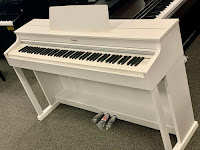 To sum it all up, given what the new Casio Celviano AP-470 is all about and what it offers, I definitely recommend this model to any family who is wanting a piano with a big, full realistic acoustic piano sound going through a fairly powerful internal speaker system housed in an attractive, durable cabinet with functions and features that puts it in a class by itself in its price range. I also want to point out that this is the first time in the Celviano AP400 series that Casio has offered an attractive matte white cabinet finish. I have seen the white color in person and it really looks good. There is only one thing I think the AP-470 may have benefited from and that is Bluetooth audio and Bluetooth MIDI for wireless connectivity with external devices.
To sum it all up, given what the new Casio Celviano AP-470 is all about and what it offers, I definitely recommend this model to any family who is wanting a piano with a big, full realistic acoustic piano sound going through a fairly powerful internal speaker system housed in an attractive, durable cabinet with functions and features that puts it in a class by itself in its price range. I also want to point out that this is the first time in the Celviano AP400 series that Casio has offered an attractive matte white cabinet finish. I have seen the white color in person and it really looks good. There is only one thing I think the AP-470 may have benefited from and that is Bluetooth audio and Bluetooth MIDI for wireless connectivity with external devices.
















Thank you for the review. How does the sound compare to the ap270 and the px870 in your experience? Both in terms of the piano sound realism and the listening experience?
The AP470 internal sound system along with the new piano samples in it is significantly upgraded over any of the other Casio pianos below this new AP470 model.
Hi Tim. Many thanks for the review. We are looking to get a piano for our daughter who has just started piano lessons. We are looking at the Casio AP470 and the Kawai KDP110. Which one is better? Thank you!
Hi Tim
How does this compare to the AP650?
Interested in functionality, sound quality and App compatibility?
Thanks David
They are both impressive digital pianos for the money, but even though the Casio AP470 is more money than the Kawai, it would be worth the extra expense if you have the budget for it. The AP470 is much easier to use, has a proprietary iOS app for iPad, etc to more intuitively use the piano, has a sound projection system with the top lid able to open up to let out the sound, has 4 speakers instead of 2 in the Kawai, has a richer piano tone because of its sampling process, has the ability to record 2-track piano practice for listening back to the student's left & right hand parts separately, has audio wav file recording for true recorded song files all of which can be saved on a USB flash drive, has height adjustable bench, 5 year complete warranty instead of 3 years on Kawai, Casio piano is available in 3 different cabinet finishes rather than just one on the Kawai. The Casio cabinet is sturdier with front support legs on it. Just depends on your budget. In either case I can help you save money beyond the internet discount prices so please contact me by email and I can explain more to you and answer more of your piano questions.
Thanks Tim. Your reply is much appreciated. We've done more research and have now shortlisted two digital pianos now – the Korg G1 Air (after reading your review of course) and the Kawai CN27.
We've tested the CN27 and liked the key action and sound. We're waiting for an opportunity to test the Korg G1 air. We're in the North of UK and it's hard to find a store near us to test it!!!
Have you tested the CN27? Which one would you recommend?
Hello! I'm currently deciding between Casio AP 470 and Korg C1 Air. Which one has better sound (both in headphones and through speakers)?
Hello Tim, thank you for all you do, I used your advice to buy a Casio in the $500 range in Canada when I was a poor student a few years ago. Now that I'm a poor worker in Europe I've moved up to the $1500 range and I'm about to go for this one. Do you think it's a good choice for someone that has been playing the family $5000 Kawai for 10 years but now needs the closest thing to a piano for a small appartment? I'd also like to improve my jazz by playing on top of youtube backing tracks, is this type of connectivity possible? Thanks again for your work!
Hello, greetings from Peru
Between your review of PX-870 and AP-470, i don't understand the difference between the models, could you please help me, i saw the Casio info and they look very simmilar
https://www.casio-intl.com/latin/es/emi/products/px870/
https://www.casio-intl.com/latin/es/emi/products/ap470/
Hello Tim,
Could you please help to identify the main differences between the AP 470 and PX 870? I'm trying to justify the extra $600 in spend and if it is worth it. My son is 7 and has been learning on a keyboard for the past 2 years, and I'm looking to upgrade as his skills are getting more advanced. Thank you for your assistance.
Abbas.
I recently purchased an AP470 through Tim and am doing the happy dance as to how I sound in the fancy steakhouse called “Prime” in St. Thomas, VI. I’ve had wrist issues and was hoping my 4 nights/wk performances wouldn’t be too taxing. I absolutely love the action and after my first 2 weeks, there is no pain. I want people so refer to this spot as having a piano, not a keyboard. This also has been accomplished. The quality of sound is so much better than I expected. I use it’s own speakers and line out into 4 house speakers and the quality has remained true throughout the restaurant I am so glad I met Tim online to help me make the decision on buying this piano.
Hello Tim. I have recently purchased an AP470. I just want to know how do you know than the main Grand piano sound is a New York Steinway. I just couldn't find that datum in the supplied docs or the Casio homepage. Thank you very much!
Although Casio cannot publish this info, they had previously confirmed that statement to me…that the piano sample is from a NY Steinway.
Hello Tim, how would you compare this piano, Casio AP470, with the Roland DP603. The Roland is more expensive, but after reading your review I believe that both can be compared. Your opinion on both these models will be highly appreciated, because I am about to buy either one of them soon.
Thank you and if you can send your opinion to alex@riveros.ca it will be even more appreciated.
Regards,
Alex
Hi, Tim: I have the AP-470 piano and really appreciate the Chordana software. Can the USB output from the piano be converted to a Bluetooth signal by any commercial adaptor? I'd like to eliminate the bother of the USB cable connection to my tablet if possible. Thanks!
Hello Tim, you mentioned that there is a mode that can be set to turn the internal speakers back on with external speakers connected. Where is this setting set? I dont find it in the app or the manual
Look for the "speaker out" mode in the AP-470 users manual under Parameters in the chart. The speaker-out mode defaults to off. Turn it "on" (look in the manual for how to do that) and then when something is plugged into the headphone jack, the speakers of the piano will still work.
How would you rate the AP470 vs. the Korg G1 Air?